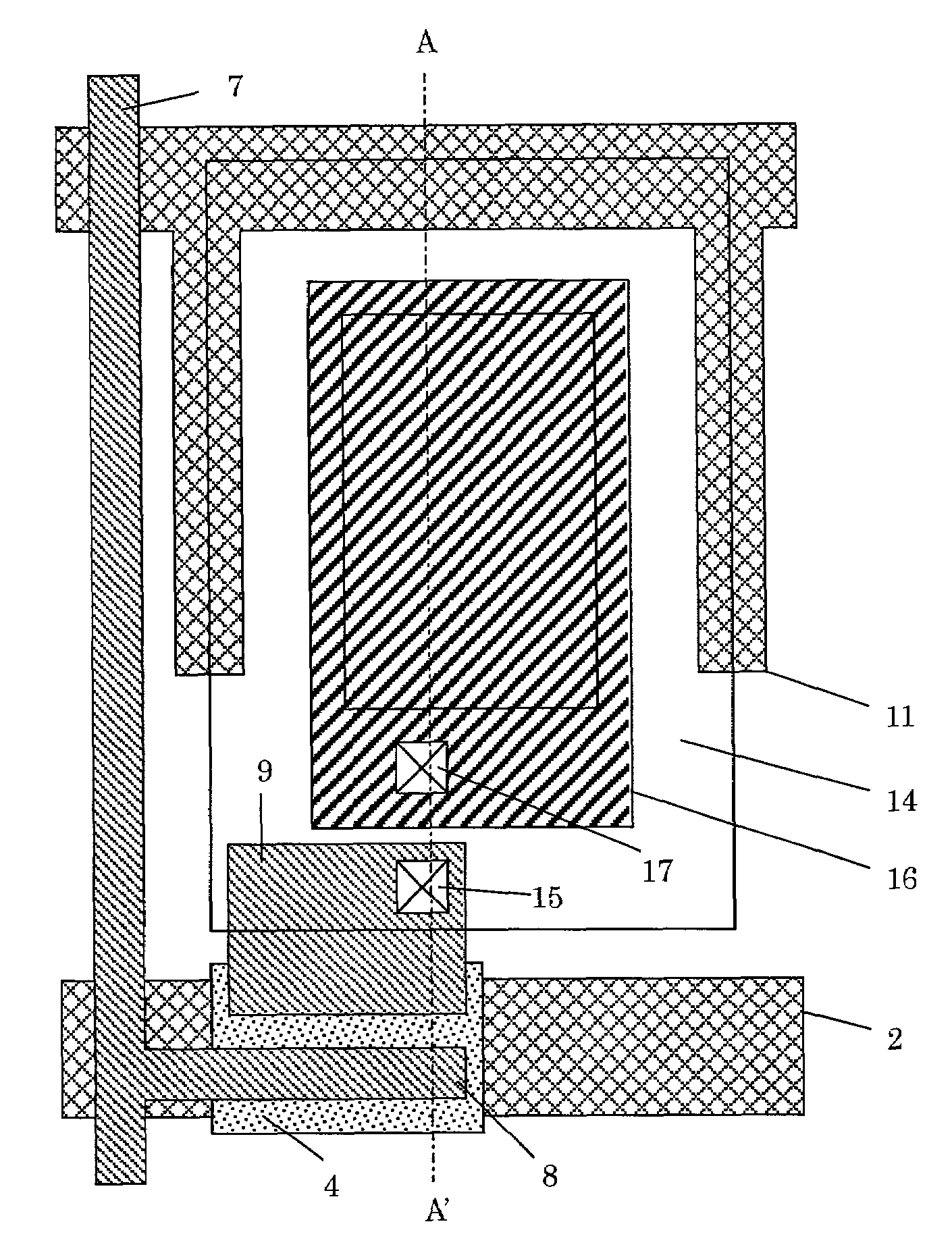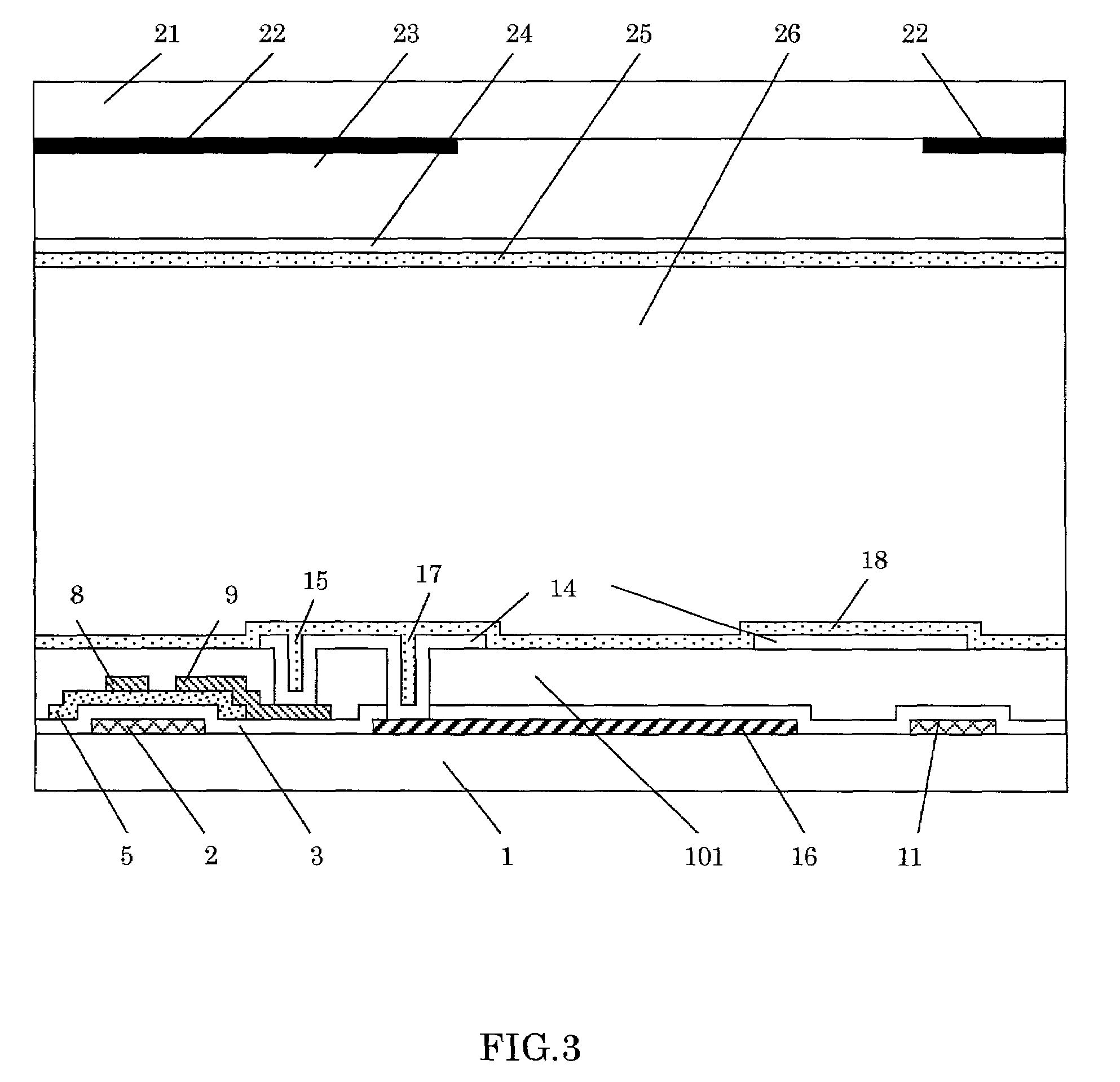Liquid crystal display device and manufacturing method therefor
a liquid crystal display and liquid crystal technology, applied in non-linear optics, instruments, optics, etc., can solve the problems of grayscale inversion in half tones, large change in transmittance, narrow viewing angle range, etc., to achieve low black brightness, wide viewing angle range, and high contrast
- Summary
- Abstract
- Description
- Claims
- Application Information
AI Technical Summary
Benefits of technology
Problems solved by technology
Method used
Image
Examples
first embodiment
[0058]The active matrix-type liquid crystal display device relating to the first embodiment of the present invention is explained using FIGS. 1, 2, and 3. FIG. 1 shows a plan view of a pixel in a TFT array substrate. FIG. 2 shows a cross sectional view of the pixel in FIG. 1 taken at the line A–A′. FIG. 3 shows a cross sectional, structural view of the display portion of the liquid crystal display device comprising a TFT array substrate, opposite substrate, and liquid crystal.
[0059]In FIG. 1, 2 shows the gate line, 4 shows the semiconductor thin film, 7 shows the source line, 8 shows the source electrode, 9 shows the drain electrode, 11 shows the Cs line, 14 shows the pixel electrode comprising a second layer of ITO, 15 shows the contact of the drain electrode 9 with the pixel electrode 14, 16 shows the pixel electrode comprising a first layer of ITO, and 17 is the contact of the pixel electrode 16 comprising the first layer of ITO with the pixel electrode 14 comprising the second l...
second embodiment
[0066]The active matrix-type liquid crystal display device relating to the second embodiment of the present invention is explained using FIGS. 4 and 5. FIG. 4 is a plan view of a pixel in the TFT array substrate; and FIG. 5 is a cross sectional view of the pixel in FIG. 4 taken at the line A–A′. In FIGS. 4 and 5, elements of the constitution having the same symbols as in FIGS. 1 and 2 show identical portions or portions corresponding to the constitution in FIGS. 1 and 2 and an explanation thereof is omitted. In FIGS. 4 and 5, 2a is the adjacent gate line. In this second embodiment, the cumulative capacitance for stabilizing the pixel potential during the holding period is formed between the pixel electrode 14 and the adjacent preceding gate line 2a.
[0067]The method for manufacturing the liquid crystal display device relating to the second embodiment is explained next. The gate lines 2 and 2a are formed by the sputtering and formation of a metal film on the glass substrate 1, and th...
third embodiment
[0070]The active matrix-type liquid crystal display device relating to the third embodiment of the present invention is explained using FIGS. 6 and 7. FIG. 6 is a plan view of a pixel in the TFT array substrate; and FIG. 7 is a cross sectional view of the pixel in FIG. 6 taken at the line A–A′.
[0071]In FIGS. 6 and 7, elements of the constitution having the same symbols as in FIGS. 1 and 2 show identical portions or portions corresponding to the constitution in FIGS. 1 and 2 and an explanation thereof is omitted. In FIGS. 6 and 7, 2a is the adjacent gate line. In this third embodiment, the storage capacitance for stabilizing the pixel potential during the holding period is formed between the pixel electrode 14 and the Cs line 11, and between the pixel electrode 14 and the adjacent preceding gate line 2a.
[0072]The method for manufacturing the liquid crystal display device relating to the third embodiment is explained next. The gate lines 2 and 2a are formed by the sputtering and form...
PUM
| Property | Measurement | Unit |
|---|---|---|
| thickness | aaaaa | aaaaa |
| positive voltage | aaaaa | aaaaa |
| positive voltage | aaaaa | aaaaa |
Abstract
Description
Claims
Application Information
 Login to View More
Login to View More - R&D
- Intellectual Property
- Life Sciences
- Materials
- Tech Scout
- Unparalleled Data Quality
- Higher Quality Content
- 60% Fewer Hallucinations
Browse by: Latest US Patents, China's latest patents, Technical Efficacy Thesaurus, Application Domain, Technology Topic, Popular Technical Reports.
© 2025 PatSnap. All rights reserved.Legal|Privacy policy|Modern Slavery Act Transparency Statement|Sitemap|About US| Contact US: help@patsnap.com



